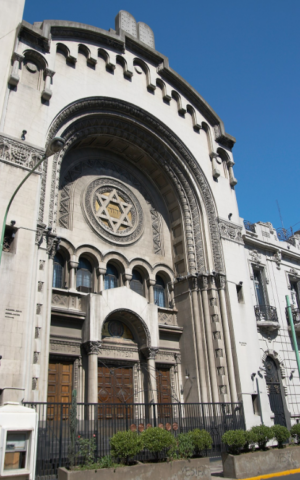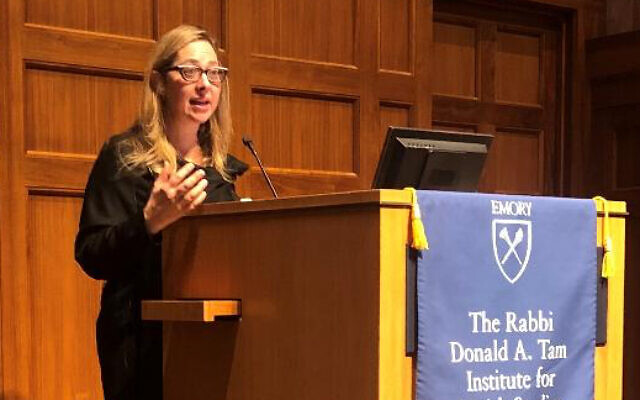Lecture Covers Latin American Jewish Influx
Since 1965 there has been a steady exodus of Jews from Venezuela, Argentina, and Mexico.
Laura Limonic was only seven when she immigrated to the United States in 1980 with her family from Argentina. Her father and mother, Alberto and Raquel, were active members of the Buenos Aires Jewish community — the largest and most important center of Jewish life in Latin America.
But it was a time of political turmoil and Jews, particularly, were a target of the repressive military junta that ruled the country. Her father had been accepted for graduate study at Brandeis University and it was thought that perhaps after a few years in the United States, life in Argentina would return to normal and the family could return.
“The idea was really just to come for two or three years, learn English, have an adventure,” Limonic says. “But as happens with so many immigrants, eventually we just stayed. I originally lived in a small town outside of Boston where we were one of three Jewish families. But eventually, we moved to Newton, Mass., which has a large Jewish population.”
Almost 44 years later, Limonic is the chair of the sociology department at the State University of New York on Long Island, and the study of Jewish immigrants from Latin America has become the focus of her research. Her book, “Kugels and Frijoles,” published in 2019. At first glance it sounds like a cross cultural cookbook, but is actually a pioneering study of how Jews from Latin America have adjusted to the process of immigration and assimilation into the American melting pot.

It also was largely the inspiration for this year’s Tenenbaum Lecture earlier this month at Emory University’s Tam Institute of Jewish Studies. She estimates that there are anywhere from 150,000 to 225,000 Jews who have come to this country, primarily from Mexico, Venezuela, and Argentina.
“I am interested in the different avenues that people take towards integrating and assimilating in this country,” Limonic points out. “I’m really thinking about how the factors that come together to allow people to make a life for themselves in their new country, given the racial constraints, and the ethnic constraints. There are all of these different ways that immigrants are able and not able to access American society.”
Limonic is particularly interested in those Latinx Jews who have come to America since the landmark Immigration and Nationality Act of 1965 became law. That legislation was co-authored by the long serving Jewish congressman from New York, Rep. Emanuel Cellar. The law made it easier for larger numbers of non-European immigrants, like the Limonic family, to come to the United States.
Many of the immigrants are descended from Ashkenazic Jews, who came to Latin America from Eastern Europe. There are Sephardic Jews here from the region, as well. Mexico has a population of Moroccan and Syrian Jews and there was a significant number of Jews from Turkey who moved to Cuba earlier in the 20th century.

According to the professor, there are sizable populations in the northeastern United States. That’s where her doctoral dissertation is centered; it was written 10 years ago about Latin Jewish immigration. There is also a concentration of Latin Jews in San Diego.
But the most significant numbers are in the neighborhoods of North Miami Beach and Aventura, Fla. According to a population study by the Greater Miami Jewish Federation, Hispanic Jews are the fastest growing ethnic group in Miami’s Jewish community. And unlike many of those immigrants who cross the Rio Grande as poor, illegal aliens, the new Latino Jews are different.
“Many or the majority of Latino Jews are immigrants with high skills. Nonetheless, one of the things that I’ve been noting is that many of the newer Latino immigrants, particularly in Miami, are supportive of some of the very restrictive immigration policies. In other words, they are happy to be here. They are happy to have their co-religionists from Latin America or Catholics from Latin America come, but they don’t necessarily believe that there should be undocumented, immigrants crossing the border.”
At the Russell Jewish Community Center in North Miami Beach, Spanish is more likely to be heard than English. Soccer and salsa dancing are among the more popular offerings at the center, which tailors its programs to the Latin American community. While the Florida center is unusual in its ethnic diversity, the make-up of the American Jewish community, according to Limonic, is beginning to look much different.
“We see a changing diversity across the American population, Jews don’t look the same anymore. And we know that there’s also, there’s conversion. There are marriages across ethnic and racial lines. There are adoptions. There’s all of these ways that the Jewish population changes.”
- Education
- Local
- Bob Bahr
- Laura Limonic
- Argentina
- Buenos Aires
- Brandeis University
- State University of New York
- Kugels and Frijoles
- immigrants
- Tenenbaum Lecture
- Emory University’s Tam Institute of Jewish Studies
- Mexico
- Venezuela
- Immigration and Nationality Act of 1965
- Rep. Emanuel Cellar
- North Miami Beach
- Greater Miami Jewish Federation.
- Russell Jewish Community Center




comments